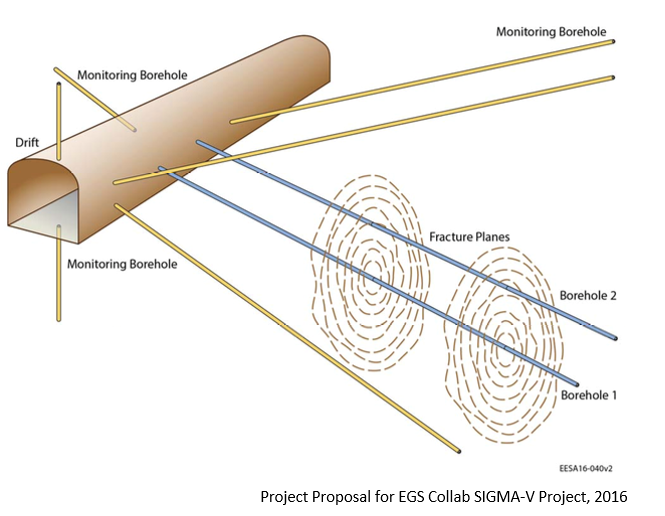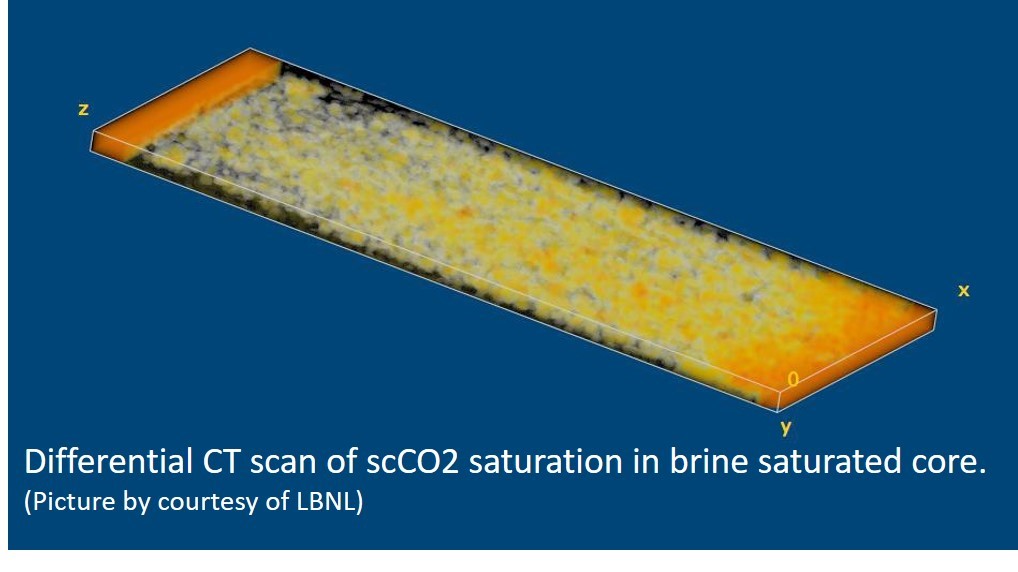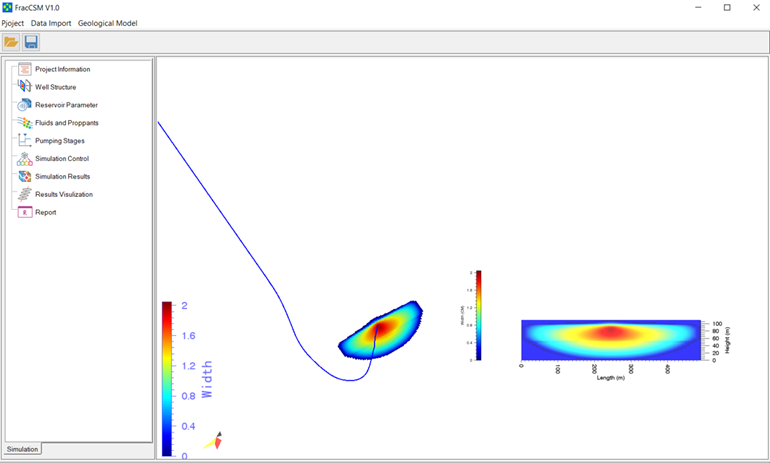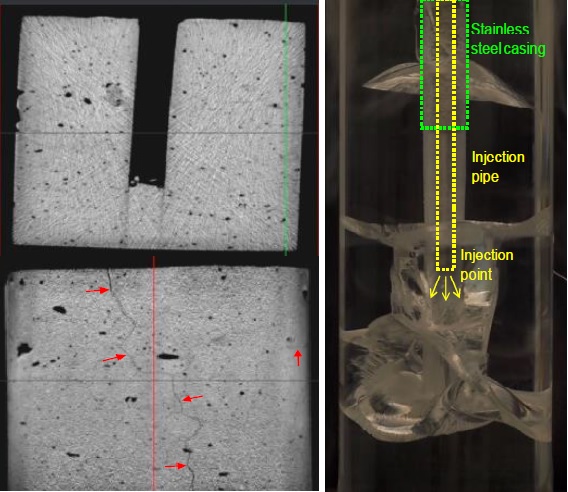Projects
The Enhanced Geothermal System (EGS) Collaborative SIGMA-V Project: Stimulation Investigations for Geothermal Modeling Analysis and Validation (Funded by DoE: 2017 – 2020)
 This project is a collaborative research project which brings skilled and experienced scientists, engineers and researchers in the areas of subsurface modeling, monitoring and experimentation to investigate intermediate-scale EGS reservoir stimulation processes and related model validation. The primary goal of this research project is to address and meet the fundamental challenges of understanding and predicting permeability enhancement and evolution in crystalline rocks for heat extraction from the reservoir. The scale of this project allows proximal monitoring which provides high-resolution geological and geophysical characterization. Field tests are carefully designed for measuring fracture characterization, fluid flow and distribution, and in-situ stress. These measurements and obtained data will facilitate Thermal-Hydrologic-Mechanical-Chemical (THMC) modeling and generating predictive models for EGS development.
This project is a collaborative research project which brings skilled and experienced scientists, engineers and researchers in the areas of subsurface modeling, monitoring and experimentation to investigate intermediate-scale EGS reservoir stimulation processes and related model validation. The primary goal of this research project is to address and meet the fundamental challenges of understanding and predicting permeability enhancement and evolution in crystalline rocks for heat extraction from the reservoir. The scale of this project allows proximal monitoring which provides high-resolution geological and geophysical characterization. Field tests are carefully designed for measuring fracture characterization, fluid flow and distribution, and in-situ stress. These measurements and obtained data will facilitate Thermal-Hydrologic-Mechanical-Chemical (THMC) modeling and generating predictive models for EGS development.
The tasks that Mines is responsible for include:
- Perform THMC modeling before stimulation and facilitate fracturing design;
- Conduct THMC modeling for mechanical evaluation after stimulation, fluid flow and heat transfer before flow tests;
- Validate model and characterize fracture geometries and permeability, fluid-heat flow properties and tracer transport using THMC model.
Quantitative Characterization of Impacts of Coupled Geomechanics and Flow on Safe and Permanent Geological Storage of CO2 in Fractured Aquifers (Funded by DoE: 2015 – 2017)
 The primary objective of this project is to develop a quantitative approach for understanding and predicting geomechanical effects on large-scale CO2 injection, flow and long-term storage in the subsurface with evaluation tools and techniques for assessing and validating CO2 flow, storage potential, and risk of leakage in fractured and/or porous reservoirs. The project will study injection pressure induced rock deformation and fracturing processes by combined laboratory studies and coupled flow-geomechanics modeling. The understandings and correlations obtained will be incorporated into the high-performance TOUGH2-CSM simulator developed at CSM and other specialized coupled geomechanics modeling tools developed at Lawrence Berkeley National Laboratory to develop modeling tools for modeling CO2-injection induced rock mechanical processes associated with CO2 storage in reservoirs to quantify flow, storage, and potential leakage pathways as well as remediation measures.
The primary objective of this project is to develop a quantitative approach for understanding and predicting geomechanical effects on large-scale CO2 injection, flow and long-term storage in the subsurface with evaluation tools and techniques for assessing and validating CO2 flow, storage potential, and risk of leakage in fractured and/or porous reservoirs. The project will study injection pressure induced rock deformation and fracturing processes by combined laboratory studies and coupled flow-geomechanics modeling. The understandings and correlations obtained will be incorporated into the high-performance TOUGH2-CSM simulator developed at CSM and other specialized coupled geomechanics modeling tools developed at Lawrence Berkeley National Laboratory to develop modeling tools for modeling CO2-injection induced rock mechanical processes associated with CO2 storage in reservoirs to quantify flow, storage, and potential leakage pathways as well as remediation measures.
The tasks to be performed are listed below:
- Development of correlations of CO2 injection enhanced fracture permeability by laboratory studies;
- Development of fundamental understandings and correlations of occurrence of CO2 injection pressure induced fracturing by laboratory studies;
- Development of CO2 flow and geomechanics-coupled mathematical models and numerical schemes for modeling fracturing growth and propagation in storage formations and caprocks;
- Incorporation of CO2 injection enhanced fracture properties and fracturing correlations/models into reservoir simulators;
- Concept and flow-mechanics coupled model validation using field data of stress measurement and/or land surface uprise;
- Development, implementation, and application of advanced modeling and optimization schemes to maximize storage capacity and to identify leaking locations.
Development of a Tight Gas Reservoir Simulator for Optimizing Single Well Hydraulic Fracturing Design and Production (Funded by CNPC-USA: 2013 – 2017)
 The primary objective of the research project is to develop a software for simulating a single well hydraulic fracturing process in tight gas reservoirs. The software has been tested in Sulige gas field in China. This software is based on a multi-process computing platform and can be run on multi-core computers.
The primary objective of the research project is to develop a software for simulating a single well hydraulic fracturing process in tight gas reservoirs. The software has been tested in Sulige gas field in China. This software is based on a multi-process computing platform and can be run on multi-core computers.
It consists following four inter-connected modules:
- A 3D hydraulic fracturing simulation module that simulates the initiation and propagation of multiple fractures from horizontal wells;
- A reservoir simulator that conducts production analysis of the fractured reservoir;
- A fracture test module that collects real-time data and conducts fracture test analysis to estimate reservoir properties;
- A fracturing optimization module that automatically designs the pumping stages of fracturing operations, based on the Generalized Pattern Search method.
Water Handling and Enhanced Productivity from Gas Shales (Funded by the DoE/RPSEA Program: 2013 – 2015)
This RPSEA project is led by the University of Southern California (USC) and Colorado School of Mines participates in the tasks related to “Modeling and Simulation of Experimental Observations.”
Objectives: To improve the fundamental understanding of the interactions between the shale matrix and the water-based fracturing fluids commonly used to stimulate production wells. An improved understanding of these interactions is needed to minimize the use of fresh water in shale-gas production operations, while at the same time improving the recovery of the gas in place. Another key focus is on reusing produced water and/or utilizing other available contaminated water sources via the application of a variety of pre-treatment options. The goal of the project will be pursued through a combination of lab-scale work, modeling, and “proof-of-concept” field-scale activities performed by a team of Engineers, Chemists and Geologists from USC, CSM, Stim-Lab, M&P and ECA, an active shale-gas producer. The efforts will leverage on our existing experience with shale characterization, geochemistry, modeling of well productivity, and the clean-up and treatment of contaminated water resources.
Methodology: A unique and consistent collection of Marcellus core samples from southwest and central Pennsylvania, provided by ECA, will form the basis of our lab-scale work towards a better understanding of interactions between the shale matrix and fracturing fluids. Our experimental program will focus on the consequences of exposing a shale fracture face to frac-fluids in terms of mass-transfer characteristics and shale-fluid interactions. Our studies will focus on mixtures of fresh and produced water as well as produced water that has undergone treatment by various approaches. Careful geochemical analysis of shale and produced water samples will allow us to investigate the principal interactions and to develop guidelines for optimal mixing, for example, of fresh and produced water. Lab-scale experiments will be performed to investigate the invasion characteristics of fluid mixtures into the micro fractures and the shale matrix itself. Modeling efforts based on the observed fracture networks and geochemical reactions will be performed to delineate the related longer-term impact on the gas production rates.
Development of Non-Contaminating Cryogenic Fracturing Technology for Shale and Tight Gas Reservoirs (Funded by the DoE/RPSEA Program: 2012 – 2015)
 This RPSEA project is led by the Colorado School of Mines, and the participants include Lawrence Berkeley National Laboratory and Pioneer Natural Resources. The objective of this project is to study, test and develop an innovative cryogenic fracturing technology for enhanced gas recovery from low-permeability shale gas and tight gas reservoirs. Specifically, we will develop innovative and effective well stimulation techniques using cryogenic fluids (e.g. liquid nitrogen or liquid CO2) to significantly increase permeability in a large reservoir volume surrounding vertical and horizontal wells. The new technology has the potential to reduce formation damage created by current stimulation methods, as well as, minimize or eliminate water usage and the potential for groundwater contamination by fracturing fluid additives.
This RPSEA project is led by the Colorado School of Mines, and the participants include Lawrence Berkeley National Laboratory and Pioneer Natural Resources. The objective of this project is to study, test and develop an innovative cryogenic fracturing technology for enhanced gas recovery from low-permeability shale gas and tight gas reservoirs. Specifically, we will develop innovative and effective well stimulation techniques using cryogenic fluids (e.g. liquid nitrogen or liquid CO2) to significantly increase permeability in a large reservoir volume surrounding vertical and horizontal wells. The new technology has the potential to reduce formation damage created by current stimulation methods, as well as, minimize or eliminate water usage and the potential for groundwater contamination by fracturing fluid additives.
The research project consists of the following three main tasks:
- experimental study of a cryogenic fracturing technology;
- investigation of shale and tight-rock cryogenic fracturing processes and conditions;
- field demonstration and assessment of permeability-improvement.
Simulation of Coupled Processes of Flow, Transport, and Storage of CO2 in Saline Aquifers (Funded by DoE: 2009 – 2014)
 To address the increasing concerns regarding greenhouse gas emissions and its impact on global climate, CO2 geologic sequestration, i.e., injecting large amounts of CO2 into deep subsurface formations for long-term storage, is considered to be a promising approach for near-term implementation. To evaluate whether geologic storage is a viable technology for reducing atmospheric emissions of CO2, it is necessary to investigate and understand the conditions under which large amounts of CO2 can be injected and stored safely for a long time (centuries to millennia) in geologic formations. CO2 geologic sequestration is a complicated process, involving multiphase flow and transport coupled with site-specific geothermal, geochemical and rock mechanical effects.
To address the increasing concerns regarding greenhouse gas emissions and its impact on global climate, CO2 geologic sequestration, i.e., injecting large amounts of CO2 into deep subsurface formations for long-term storage, is considered to be a promising approach for near-term implementation. To evaluate whether geologic storage is a viable technology for reducing atmospheric emissions of CO2, it is necessary to investigate and understand the conditions under which large amounts of CO2 can be injected and stored safely for a long time (centuries to millennia) in geologic formations. CO2 geologic sequestration is a complicated process, involving multiphase flow and transport coupled with site-specific geothermal, geochemical and rock mechanical effects.
This five-year project aims to develop a comprehensive reservoir simulator to model the non-isothermal multiphase flow and transport of CO2 in saline aquifers with heterogeneity, anisotropy, and fractures and faults, coupled with geochemical and geomechanical processes that would occur during CO2 geological sequestration (GS) processes. The designed model will utilize petascale computations to allow rapid and efficient modeling assessment of GS injection strategies and long-term prediction of GS system behavior.
Development of Advanced Thermal-Hydrological-Mechanical-Chemical (THMC) Modeling Capabilities for Enhanced Geothermal Systems (Funded by DoE: 2010 – 2013)
 The primary objective of this project is to develop an advanced, comprehensive, and efficient reservoir simulator for modeling multiphase, multidimensional fluid and heat flow, coupled with effects of rock deformation and chemical reaction, in Enhanced Geothermal Systems EGS geothermal reservoirs. Specifically, the proposed project is to develop 1) conceptual models and improved modeling approaches for integrating thermal, mechanical, hydrological and chemical processes in a geothermal reservoir into a single comprehensive mathematical model; and 2) to incorporate conceptual models into a numerical modeling tool for characterization, assessment, and management of EGS systems. The developed simulator will be able to quantify and model physical and chemical processes occurring in EGS reservoirs, the long-term performance of them and evaluate the optimum design and production strategies for EGS systems.
The primary objective of this project is to develop an advanced, comprehensive, and efficient reservoir simulator for modeling multiphase, multidimensional fluid and heat flow, coupled with effects of rock deformation and chemical reaction, in Enhanced Geothermal Systems EGS geothermal reservoirs. Specifically, the proposed project is to develop 1) conceptual models and improved modeling approaches for integrating thermal, mechanical, hydrological and chemical processes in a geothermal reservoir into a single comprehensive mathematical model; and 2) to incorporate conceptual models into a numerical modeling tool for characterization, assessment, and management of EGS systems. The developed simulator will be able to quantify and model physical and chemical processes occurring in EGS reservoirs, the long-term performance of them and evaluate the optimum design and production strategies for EGS systems.
This four-year model development project includes the following studies and tasks:
- Develop a general framework model for multiphase fluid and heat flow in porous and fractured geothermal reservoirs;
- Develop a computational module for handling coupled effects of pressure and temperature variation induced rock deformation;
- Develop/implement a chemical reaction module to include important chemical species and their reactions in EGS geothermal systems;
- Develop/implement the most advanced parallel simulation technologies;
- Develop a general fracture conceptual model; and
- Verify and apply the EGS simulator using laboratory and field data for geothermal reservoirs.
Investigation of Mathematical Models and Their Applications for Oil, Water and CO2 Flow in Reservoirs (Funded by PetroChina)
The primary objective of this project is to develop a comprehensive mathematical model for describing CO2 displacement and subsurface storage in reservoirs, taking into account diffusion and dispersion of CO2 in multiphase reservoir fluids, physical and chemical reactions between fluids and rock.
The key factors and processes to be included are:
- diffusion and dispersion of CO2 in formation and in-situ multiphase fluids;
- physical and chemical reactions between CO2 mixtures, formation rock and fluids during CO2 flooding and storage in reservoirs;
- mass transfer between CO2 and crude oil and changes in crude oil composition (extraction, or asphalt precipitation, etc.), in order to handle multiphase flow and phase behavior in CO2/oil/brine/rock systems.